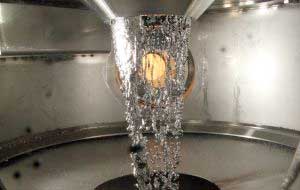| Mar 07, 2019 |
Liquid metal research: New solutions for the energy transition
|
|
(Nanowerk News) Whether for thermal energy storage systems, new process paths for the emission-free production of hydrogen, or innovative large-scale solar power plants: liquid metal technologies developed by Karlsruhe Institute of Technology (KIT) can accelerate decarbonization of the energy system.
|
|
The latest special report of the Intergovernmental Panel on Climate Change (IPCC) could hardly have been clearer: only the implementation of unprecedented changes in all areas of society, might avert catastrophic effects of global warming, the climate researchers say. They point out that the next few years will be decisive to the success of these efforts.
|
|
Scientists of KIT support the change required for preserving our natural livelihood with close-to-practice innovations. New approaches and long-standing expertise are combined by the Liquid Metal Competence Platform Karlsruhe (LIMCKA) which pools the expertise of several institutes and laboratories of KIT.
|
|
“Metal melts have excellent thermal properties. They can take up, transfer, and store heat very well. Hence, they are suited for use in a wide range of novel climate-friendly energy technologies,” says Dr. Alfons Weisenburger, the coordinator of LIMCKA. “If implemented resolutely, these technologies might accelerate the necessary decarbonization of the energy system.”
|
 |
| The test facilities of the KArlsruhe Liquid metal LAboratory (KALLA) are used to study thermal fluid dynamics of metal melts. (Photo: Karsten Litfin, KIT)
|
Storage of Heat and Power
|
|
According to the IPCC special report, quick phase-out of the use of coal is a necessary prerequisite for limiting the consequences of climate change. However, coal-fired power plants are still contributing to grid stability in these times of increasingly volatile electricity production from renewable resources.
|
|
A potential solution: coal-fired power plants can be turned into thermal energy storage power plants, with continued use of existing turbines, generators, and grid connectors.
|
|
“The core element of such a plant, the thermal storage system, and reconversion into electricity can be operated very efficiently with the help of liquid metals,” says Dr. Julio Pacio from the Karlsruhe Liquid Metal Laboratory (KALLA) of KIT. Research into innovative energy storage systems of high capacity also covers direct storage of electrical energy in liquid metal batteries. Keys to this process are innovative materials made by KIT.
Together with the German Aerospace Center (DLR), KIT is presently setting up a joint research infrastructure, the National Demonstrator for Isentropic Energy Storage (NADINE).
|
Pure Hydrogen by Methane Cracking
|
|
Natural gas often is considered a clean alternative to coal. But combustion of fossil natural gas that mainly consists of methane produces climate-damaging CO2 emissions. Scientists of KIT and the Institute for Advanced Sustainability Studies (IASS) in Potsdam have now succeeded in using natural gas in a climate-neutral way.
|
|
“We use liquid metal technology to separate methane into gaseous hydrogen and solid, elemental carbon,” says Professor Thomas Wetzel of KIT’s Institute of Thermal Process Engineering.
|
|
During pyrolysis, methane is continuously fed from below into a column of liquid tin kept at up to 1200°C. There, it forms a swarm of ascending bubbles. When the gas in the bubbles reaches the temperature required for cracking, it disintegrates. Gaseous hydrogen is released at the surface of the liquid tin and the carbon powder can be removed.
|
|
“On the laboratory scale, we demonstrated continuous operation at a conversion rate of up to 78%,” Wetzel says.
|
|
The new process won the 2018 Innovation Award of German Gas Industry and is presently being transferred from the laboratory to application in cooperation with industry partners.
|
Solar Power Plants of the Next Generation
|
|
According to the International Energy Agency (IEA), only about one quarter of the electricity produced worldwide is based on renewable energy sources. A technology suited for increasing this share is concentrated solar power (CSP).
|
|
In CSP plants, mirrors concentrate sunlight onto an absorber, a system in which a heat transfer fluid is heated up by the concentrated light. The heat can be converted directly into power by a classical power plant process or stored at low cost for conversion into electric power during periods with low levels of sunlight or in the night.
|
|
When using liquid metals, economic efficiency of CSP plants is enhanced in comparison to the presently used technology based on salt melts.
|
|
“Due to the higher fluid temperatures, we can reach an increased conversion efficiency in the power plant process and due to the excellent heat transfer properties, the size of absorbers may be halved to reach the same output,” says Professor Robert Stieglitz of KIT’s Institute for Applied Thermofluidics. “There is a lot of interest for our technologies in the relevant industries.”
|
|
Moreover, researchers at LIMCKA develop innovative sodium-based direct converters, so-called alkali metal thermal electric converter cells (AMTEC cells) for direct electrochemical conversion of heat into electricity at solar power plants.
|
|
“We have already built and successfully operated a lab-scale prototype,” says Dr. Wolfgang Hering of KIT’s Institute for Neutron Physics and Reactor Technology (INR), another partner of LIMCKA.
|
|
LIMCKA combines expertise in thermal fluid dynamics, materials sciences, and process engineering with long-standing expertise in engineering and operation of test facilities for liquid metal research. This interdisciplinary collaboration is the key to the developments made.
|

